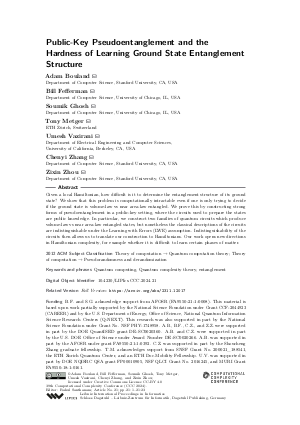@InProceedings{bouland_et_al:LIPIcs.CCC.2024.21,
author = {Bouland, Adam and Fefferman, Bill and Ghosh, Soumik and Metger, Tony and Vazirani, Umesh and Zhang, Chenyi and Zhou, Zixin},
title = {{Public-Key Pseudoentanglement and the Hardness of Learning Ground State Entanglement Structure}},
booktitle = {39th Computational Complexity Conference (CCC 2024)},
pages = {21:1--21:23},
series = {Leibniz International Proceedings in Informatics (LIPIcs)},
ISBN = {978-3-95977-331-7},
ISSN = {1868-8969},
year = {2024},
volume = {300},
editor = {Santhanam, Rahul},
publisher = {Schloss Dagstuhl -- Leibniz-Zentrum f{\"u}r Informatik},
address = {Dagstuhl, Germany},
URL = {https://drops.dagstuhl.de/entities/document/10.4230/LIPIcs.CCC.2024.21},
URN = {urn:nbn:de:0030-drops-204175},
doi = {10.4230/LIPIcs.CCC.2024.21},
annote = {Keywords: Quantum computing, Quantum complexity theory, entanglement}
}

 Creative Commons Attribution 4.0 International license
Creative Commons Attribution 4.0 International license



















